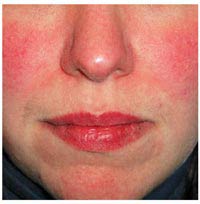Summary
- Rosacea is a fairly common chronic, inflammatory disease of the face. It is characterised by red spidery blood vessels and red bumps (papules) on the cheeks and possibly the forehead, cheeks, chin and nose.
- The exact cause of the condition is unknown, but it is believed that several factors, including environmental and genetic factors, may be involved.
- A clinical examination by a dermatologist would determine if you have rosacea. In some cases, a skin biopsy might be necessary.
- The condition, though chronic, fluctuates in most people. For this reason, treatment may only be needed intermittently. Treatment options include application of a topical gel, oral antibiotics, or laser treatment in more persistent cases.
- There is no cure for rosacea. However, the condition can be controlled effectively in most people.
- Medical treatment is usually required – the earlier the condition is treated, the better the outcome.
What is rosacea?
Rosacea is a fairly common chronic, inflammatory disease of the face. It is characterised by redness and red bumps (papules) on the cheeks and possibly the forehead, cheeks, chin and nose. It also sometimes affects the eyes.
Adults, especially women between the ages of 40 and 50, are mostly affected. However, the condition occurs in both sexes and among people of all ages and skin types (even though there is a slightly higher risk among people with fair skin).
What causes rosacea?
Rosacea, previously called "acne rosacea", has nothing to do with "ordinary" acne. Although rosacea can lead to red bumps on the face, no link has been found between rosacea and the bacteria usually associated with pimples.
Blackheads (comedones), a common feature of acne, are also not associated with rosacea.
The exact cause of rosacea is unknown, but it is believed that several factors may be involved. It has been suggested that environmental and genetic factors may play a role and some researchers believe that blood vessels which expand too easily may be a causative factor.
What are the symptoms?
Symptoms include:
- Red, spidery blood vessels (telangiectasia) on the face.
- Papules and pustules (pimples with yellow heads) occurring in the red areas. Solid papules on the skin may later become painful.
- A burning feeling where it's red, as well as slight swelling and flushing.
- Eyes and eyelids may become inflamed at a later stage (ocular rosacea), although this is less common. Eyes can also become dry, irritated and light-sensitive, and vision may become blurred.
- Thickening of the nose (rhinophyma) may occur, but fortunately this is far less common. Rhinophyma mostly affects men.
Subtype 1: Flushing and persistent redness. Visible blood vessels may also appear.
Subtype 2: Persistent facial redness with bumps or pimples. Often seen following or with facial redness.
Subtype 3: Skin thickening and enlargement, usually around the nose.
Subtype 4: Watery or bloodshot appearance, irritation, burning or stinging of the eyes.
How is it diagnosed?
A clinical examination by a dermatologist would determine if you have rosacea. In some cases, a skin biopsy might be necessary.
If eye problems occur, your dermatologist may refer you to an ophthalmologist for examination.
How is it treated?
The condition, though chronic, fluctuates in most people. For this reason, treatment may only be needed intermittently.
It's important to consult a dermatologist for topical and/or systemic (oral) therapy. This may include treatment with a topical gel containing metronidazole or administration of oral tetracycline (an antibiotic).
Red veins can be treated by cautery. This is painful and there is a risk of scarring.
Laser treatment is also an option for later-stage rosacea. Note that this should only be performed by a qualified dermatologist who specialises in laser treatment.
An opthalmologist should be consulted if eye problems occur. Steroid eye drops and oral antibiotics may be prescribed.
What is the prognosis?
Rosacea is a chronic condition for which there is no cure. However, with the correct treatment, the condition can be controlled in most people. While the papules and pustules are relatively simple to treat, the redness and spidery blood vessels can be more persistent.
When to call your doctor
Medical treatment is usually required. Your best approach would be to consult a dermatologist who can examine the area and decide on the appropriate treatment. The earlier you seek treatment, the better.
How can rosacea be prevented?
Too little is known about the exact cause to recommend preventative steps for people who don't have rosacea.
However, the following actions may help to prevent flare-ups if you have been diagnosed with the condition:
- Use sunscreen (SPF 30+) that protects against both UVA and UVB rays.
- Wash your face once a day, using a gentle cleanser. Avoid facial products that may irritate the skin, e.g. products containing alcohol, menthol or eucalyptus oil. Pat your skin dry with a clean towel.
- Keep a record of when flare-ups occur and try to avoid possible triggers. These may include alcohol, hot drinks, spicy foods, emotional stress, heat or cold.
Reviewed by Dr Dilshaad Asmal, MB Chb MMed(Derm)
Images supplied by the United States National Rosacea Society (www.rosacea.org).
Last updated: 2008/02/04




 Publications
Publications
 Partners
Partners




















